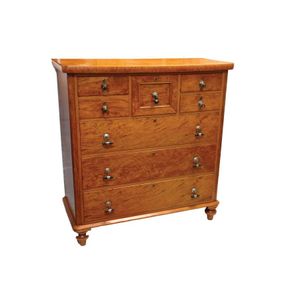Early 19th Century Baltic Pine Chest of Drawers
You must be a subscriber, and be logged in to view price and dealer details.
Subscribe Now to view actual auction price for this item
When you subscribe, you have the option of setting the currency in which to display prices to $Au, $US, $NZ or Stg.
- A/f, as Inspected - The letters "A/F" or "as inspected" as part of a description is the cataloguer's shorthand for "all faults" or "as found", meaning the item has some type of damage or deficiency, it is of uncertain date or provenance, and/or that the seller takes no responsibility for the completeness of the item or the accuracy of the description.
- Cabriole Leg - The cabriole leg evolved from an elongated scroll, curving out at the knee which may or may not be carved, and forming a serpentine shape as it descends to the foot.
First introduced into English furniture in the late 17th century, cabriole legs were widely used during the Queen Anne and early Georgian periods, where they frequently terminated in a pad foot or ball and claw foot. The style has had many imitators since then. The cabriole leg was re-introduced in the mid-19th century, and is commonly associated with the balloon-back dining or drawing-room chairs made in walnut, mahogany or, in Australia, cedar. The Victorian cabriole leg, on the whole, was rather more slender than the earlier form, following the French style, which emphasized the delicacy and daintiness of the chairs they were designed to support. Cabriole legs are sometimes found on windsor chairs, especially those made during the 18th century.
This item has been included into following indexes:
Visually similar items

Antique, early 19th century French Empire marble topped, cherrywood four drawer commode, approx 90 cm high, 130 cm wide, 60 cm deep

A small Georgian mahogany writing cabinet, the rectangular top sits above a drawer leaf with a felt panel. The cabinet comprises four drawers applied with brass handles and lock faces, all raised on four bracket feet, 75 cm high, 79 cm wide, 46.5 cm deep

A 19th century mahogany campaign chest, raised on bracket feet, the lower half with two full width drawers, the top with one full width and two of half width, inset brass drawer handles and with brass handles to the sides of both portions, brass strapping,

A good quality William Norrie New Zealand colonial kauri scotch chest, with mottled facings, the central top hat drawer with a pair of small drawers on either side and three deep full width drawers below, rounded side edges, deep plinth top, short turned l
